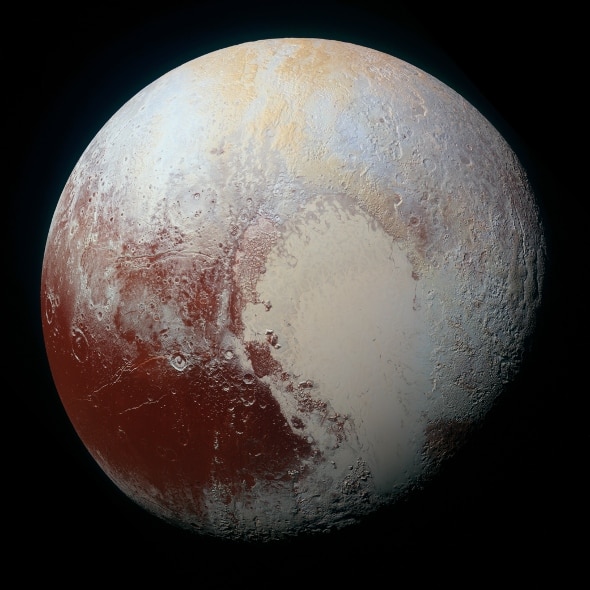Create a free profile to get unlimited access to exclusive videos, sweepstakes, and more!
Pluto. Oh My, Pluto.

I was going to write a big flowery introduction to preface this new image of Pluto from the New Horizons spacecraft, but screw that.
Just look at it. Seriously. Look.
That ridiculously gorgeous picture is actually a combination of three images shot by New Horizons, one each using a blue, red, and near-infrared filter. So this isn’t what you’d see with your own eyes if you flew past Pluto (and weren’t dead from hypothermic anoxia), but it’s still simply amazing. By the way, this is a very, very ensmallened version of the picture; click it to get a 2,000 x 2,000 pixel version.
Or, you could grab the 8,000 x 8,000 pixel shot. Y'know. If you want.
As usual, Emily Lakdawalla does a great job explaining all this. In a nutshell, it was taken by the Multi-Spectral Visible Imaging Camera. It has several detectors on it, three of which are dedicated to seeing blue, red, and infrared. They use what’s called the “pushbroom” technique to take images, basically sweeping across an object like a scanner does when you scan a document. It’s a commonly used technique for spacecraft, so you don’t have to build a huge detector.
What can you say about this shot, though? Pluto is gorgeous! You can see the heart-shaped Sputnik Planum feature in the middle, and some terrain on the left that’s highly reflective in infrared (colored red in the photo). Those highlands are pocked with craters, in contrast to Sputnik, which is smooth—that’s an indicator of relative age; smooth terrain has probably been resurfaced, and so it’s younger.
I’m pretty interested in the higher surface features you can see that define the left side of the heart. What could cause such tall mountains so close to lower terrain?
And check out this close-up of a region near the leftmost part of the heart:
Whoa. Mountains pop up higher than the nitrogen ice plain below … which isn’t as smooth as I first thought. It appears almost corrugated, like it’s stippled with dunes. There’s no word yet on what’s actually causing that; the ice might be sublimating (turning directly into a gas), which could cause a rippling effect.
Again, Emily has more close-ups and discussion, care of Alex Parker, the astronomer who created this jaw-dropping image. NASA has a few more detailed shots as well, including the highest-resolution map ever made of the surface of Pluto.
Remember, too, that new raw images are released every week on the New Horizons website. You should check there to see what’s hot off the interplanetary presses; it’ll take the better part of a year to get all the data back from the spacecraft. These marvels are just the beginning. It’s a whole new world out there on the edge of the main solar system. A lot more wonder awaits.


























